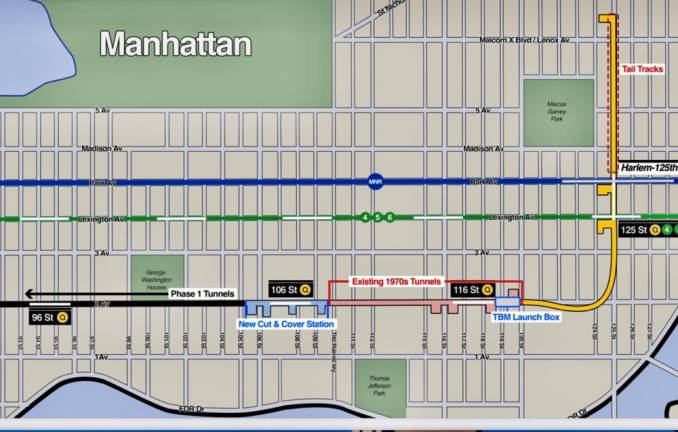Five blocks on UES to be Torn Up as MTA Inches Foward with New Q Line Extension
Five city blocks between E. 105th St. and E. 110th St. will be torn up in order to move undergound utilities as the first step in constructing a new Q line stop at 106th St. Over the course of ten years, three new stops will be added at E. 106th St., E. 116th St. and E. 125th St./Park Ave.



Shovels will be in the ground starting in March for the $182 million contract to relocate underground power and utility lines as a first step to extend the Second Avenue subway from 96th St to E. 125 Street in Harlem.
A completion date for the new $6.9 Billion extension is targeted for the early-2030s.
The downside: the initial contract will necessitate tearing up the five blocks of Second Ave. from E. 105th to E. 110th St. along the site of the future 106th St. Station. Down the road, the MTA in planning to add new stations at E. 116th St. and E. 125th St/ Park Ave.
“We’re moving full speed ahead to extend the Second Ave. subway to East Harlem, expanding transit access for thousands of New Yorkers,” Gov. Kathy Hochul said at the Jan. 22nd kickoff of the latest phase. “This critical milestone will put shovels in the ground for the next phase of this transformative project. East Harlem has dreamed of transit access for decades–and we’re committed to getting the job done.”
MTA officials say that at some point, the hope is to continue the Q line westward along 125th St. just past Malcolm X. Blvd on the west side not far from the northern end of Central Park. There is already a not-for-profit group called “Uptown Grand Central” that has formed and is pushing for improvements along 125th St.
C.A.C. Industries, Inc. a NYC-based heavy civil contractor specializing in New York City infrastructure projects including the High Line is handling the first component of the Second Ave. subway Phase 2 project. The work is the first of four construction contracts for the new line, relocating underground utilities.
Initial plans for a full Second Ave. subway date back over 100 years, with fitful starts until construction of Phase 1 began in April 2007. When Phase 1 opened six years ago, Second Ave. saw brand-new Q train stations at 72nd, 86th and 96th streets that were carrying 200,000 daily riders prior to the start of the pandemic in 2020.
The new Phase 2 extension to 125 Street, will connect to the Metro-North and the 4, 5, and 6 Lexington Ave. lines, with three new ADA-accessible stations.. While 106th and 116th Street Stations will be 45 feet deep, the 125th Street Station will have to plunge 125 feet below street level, in order to duck under the existing Lexington Ave. subway lines. That station will have a mezzanine level, like the Phase 1 stations. Each new station will have above-ground ancillary buildings to house ventilation, mechanical, and electrical equipment, as well as space for possible ground-floor retail and community uses.
Expectations are that there will be 100,000 average daily riders on the new extension, with 30 trains per hour, MTA officials said. Additionally, the 125th St/ Park Avenue station will be a multimodal transit connectivity with connections to the 4 5 6, Metro-North trains and the M60 Select Bus Service to LaGuardia Airport and other NYC Transit buses.
While Phase 1 cost $2.5 Billion per mile to build, Phase 2 is slated to have a much lower cost; previous tunneling was completed to 105th Street from 96th Street. Use of an original 1970s-built tunnel segment from 110 Street to 120 Street along Second Avenue will also help cut costs. Other financial containment initiatives in Phase 2 include early real estate acquisition, best value contract structures, reduction in back-of-house and ancillary space, and close coordination of contracts.
“The MTA is implementing valuable lessons learned from past projects into Phase 2 of the Second Ave. subway, and this contract reflects our new approach by proactively relocating utilities upfront,” said Jamie Torres-Springer, MTA Construction and Development president
Complex, largely unmapped utility networks could add delays and costs to the start of the project, officials said.
“There is an element of unknown of the ground conditions, and we could possibly hit water, which could delay the project,” Mark Roche, the· MTA Deputy Chief Development Officer-Delivery, noted.
The next three contracts of Phase 2, involving new tunneling, stations and systems will largely depend on the adoption of congestion pricing for funding. It is expected to raise up to $1 billion annually to be directed toward the MTA but the tolling system is facing a number of legal challenges. The MTA still hopes to have the tolls clicking by May.